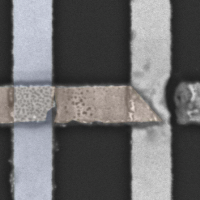Magnetic memories
CEEM’s researchers lead Europe in the quest for the new materials that will be needed when spintronics displaces volatile semiconductor technology within the next ten years.
Our strength in spintronics – from magnetic-domain imaging to spin-current interference – is reflected in the appointment of Professor Atsufumi Hirohata to head the €1.8 million international HARFIR project.
This joint EU-Japanese project has the urgent task of developing alternative inexpensive alloys to replace the rare metal Iridium, which is widely used in all spin electronic devices – including hard disk drives and next-generation magnetic memories.
“The price of iridium is expected to soar perhaps by a factor of 100 due to its wider applications. Therefore the lack of availability of one crucial element from within the periodic table is a critical issue to be solved urgently,” Professor Hirohata said.
Professor Hirohata is also pioneering non-destructive techniques for mapping buried electronic interfaces in multilayered junctions. This will pave the way for greater transport efficiency across junctions: an approach with wide applications from conventional semiconductors and metal devices to organic devices.
This work has led to a patented technology that will both deepen the our understanding of what is happening at the atomic level of multi-layered, nanoscale materials; but also provides manufacturers with a tool that can assess these materials for defects without having to mill or slice the material to obtain a cross section.
Contact us
Centre for Energy Efficient Materials
ceem@york.ac.uk
+44 (0)1904 322251
School of Physics, Engineering and Technology,
University of York,
Heslington,
York,
YO10 5DD
Related links

Scanning electron microscopy image of a broken NiFe/Cu junction

"CEEM’s new technique provides a quicker, more cost-effective alternative to current cross-sectional methods, and could improve the production process for multiple industries such as electronics and medical manufacturers."
- Professor Atsufumi Hirohata, School of Physics, Engineering and Technology
His work with global data storage manufacturer, Seagate, has led to the development of more energy efficient materials that use spin polarised electrons - which have the potential to dramatically reduce the energy needed to power not only mobile phones and computers, but also the huge data warehouses that store information.
Seagate have funded PhD studentships at CEEM and are working with the team to both understand the fundamental science behind these materials and discover potential pathways for bringing them to the market.
CEEM’s ability to carry out this path-finding research is built on three complementary qualities:
- World leading expertise in predictive modelling
- Facilities to fabricate materials and interfaces at the atomic level, using modelling to refine and improve their properties
- Unrivalled experimental analysis using bespoke electron microscopes.
Contact us
Centre for Energy Efficient Materials
ceem@york.ac.uk
+44 (0)1904 322251
School of Physics, Engineering and Technology,
University of York,
Heslington,
York,
YO10 5DD
Related links

Scanning electron microscopy image of a broken NiFe/Cu junction